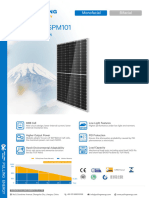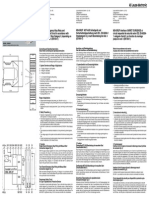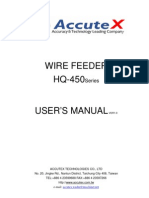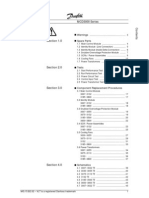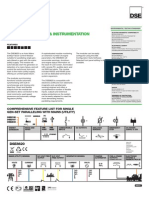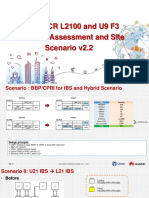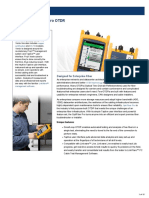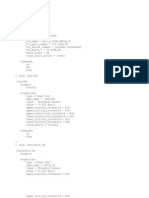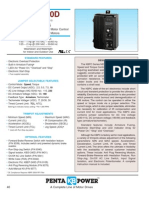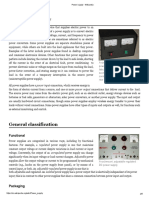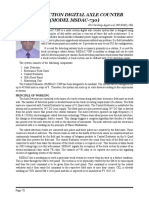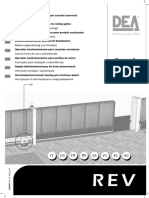RX-2123 Ii2 Qi 1-1-0
RX-2123 Ii2 Qi 1-1-0
Uploaded by
JoelMalangCopyright:
Available Formats
RX-2123 Ii2 Qi 1-1-0
RX-2123 Ii2 Qi 1-1-0
Uploaded by
JoelMalangOriginal Description:
Original Title
Copyright
Available Formats
Share this document
Did you find this document useful?
Is this content inappropriate?
Copyright:
Available Formats
RX-2123 Ii2 Qi 1-1-0
RX-2123 Ii2 Qi 1-1-0
Uploaded by
JoelMalangCopyright:
Available Formats
USER MANUAL FOR RX-2123
RX-2123
WCDMA2100 DIGITAL CHANNEL
SELECTIVE REPEATER
USER MANUAL
The information contained herein is the
responsibility of and is approved by the
following, to whom all enquiries should
be directed in the first instance:
Comba Telecom Ltd.
This is an unpublished work the copyright in which vests in Comba International ("Comba"). All rights reserved.
The information contained herein is confidential and the property of Comba a d is supplied without liability for errors or
omissions. No part may be reproduced, disclosed or used except as authorised by contract or other written permission. The
copyright and the foregoing restriction on reproduction and use extend to all media in which the information may be embodied.
RX-2123 II2 QI
ENU Status : 1-1-0
Copyright - refer to title page
Page 1
USER MANUAL FOR RX-2123
0.2
CONTENTS
Section
Page
0.2
0.3
0.4
0.5
0.6
CONTENTS ........................................................................................................................... 2
INDEX TO FIGURES AND TABLES ..................................................................................... 4
HISTORY ............................................................................................................................... 5
GLOSSARY OF TERMS ....................................................................................................... 6
SAFETY NOTICES AND ADMONISHMENTS ...................................................................... 7
GENERAL INFORMATION ................................................................................................... 8
2
2.1
2.2
2.3
2.4
EQUIPMENT DESCRIPTION.............................................................................................. 10
SYSTEM DIAGRAM ............................................................................................................ 10
EQUIPMENT LAYOUT ........................................................................................................ 11
EQUIPMENT CONSTITUTION ........................................................................................... 12
KIT OF PARTS .................................................................................................................... 12
3
3.1
3.2
3.3
3.3.1
3.3.2
3.3.3
3.3.4
3.3.5
3.3.6
3.4
3.4.1
3.4.2
3.4.3
3.4.4
3.4.5
3.4.6
3.4.7
INSTALLATION ................................................................................................................... 13
WARNINGS AND ALERTS ................................................................................................. 13
SITE PLANNING CONSIDERATIONS................................................................................ 14
INSTALLATION PROCEDURES ........................................................................................ 15
GOODS INWARDS INSPECTION ...................................................................................... 15
TOOLS................................................................................................................................. 15
PREPARATION ................................................................................................................... 15
WALL MOUNTING .............................................................................................................. 16
POLE MOUNTING OF MOUNTING RACK......................................................................... 17
DRIP-LOOP ......................................................................................................................... 17
EQUIPMENT CONNECTORS ............................................................................................ 18
CONNECTORS ................................................................................................................... 18
GROUNDING CONNECTION ............................................................................................. 19
LI-ION BATTERY CONNECTION ....................................................................................... 19
RF CONNECTION............................................................................................................... 19
EXTERNAL ALARM CONNECTION ................................................................................... 19
CONNECTION BETWEEN PC AND EQUIPMENT ............................................................ 20
EXT ALARM CONNCETION ............................................................................................... 20
4
4.1
4.2
4.3
COMMISSIONING ............................................................................................................... 21
PRE-COMMISSIONING TASKS ......................................................................................... 21
MCU LED INDICATORS ..................................................................................................... 21
COMMISSIONING PROCEDURES .................................................................................... 22
5
5.1
5.1.1
5.1.2
5.1.3
5.2
5.3
5.3.1
5.3.2
5.3.3
5.3.4
5.3.5
5.4
5.4.1
5.4.2
OMT ..................................................................................................................................... 24
LOCAL AND REMOTE CONNECTIONS TO OMT ............................................................. 24
CONNECTION FROM PC TO OMT.................................................................................... 24
LOCAL CONNECTION TO OMT ........................................................................................ 25
REMOTE CONNECTION TO OMT ..................................................................................... 25
OMT CONFIGURATION ..................................................................................................... 26
RF PARAMETER ................................................................................................................ 26
SWITCH............................................................................................................................... 26
CHANNEL NO. .................................................................................................................... 27
ATT ...................................................................................................................................... 28
ALARM THRESHOLD ......................................................................................................... 28
ALARM INFORMATION ...................................................................................................... 28
PROPERTIES INFO. ........................................................................................................... 30
EQUIPMENT ID ................................................................................................................... 30
COMM. CONFIG ................................................................................................................. 30
RX-2123 II2 QI
ENU Status : 1-1-0
Copyright - refer to title page
Page 2
USER MANUAL FOR RX-2123
6
MAINTENANCE .................................................................................................................. 32
7
7.1
7.2
7.3
APPENDICES...................................................................................................................... 33
APPENDIX A: TOOLS FOR INSTALLATION AND MAINTENANCE ................................. 33
APPENDIX B: SERVICING POLICY AND RETURN OF EQUIPMENT ............................. 34
APPENDIX C: RMA (RETURN MATERIAL AUTHORIZATION) FORM ............................. 35
RX-2123 II2 QI
ENU Status : 1-1-0
Copyright - refer to title page
Page 3
USER MANUAL FOR RX-2123
0.3
INDEX TO FIGURES AND TABLES
Figure 1: Views of RX-2123 Enclosure .........................................................................................................9
Figure 2: RX-2123 System Diagram .......................................................................................................... 10
Figure 3: RX-2123 Internal Layout ............................................................................................................. 11
Figure 4: Mounting Rack Overview ............................................................................................................ 15
Figure 5: Wall Mounting ............................................................................................................................. 16
Figure 6: Pole Mounting Overview ............................................................................................................. 17
Figure 7: Bottom Panel Interface Diagram ................................................................................................ 18
Figure 8: The Connection between Equipment and PC ............................................................................ 20
Figure 9: PC Protocol Setting .................................................................................................................... 24
Figure 10: Connection Type....................................................................................................................... 25
Figure 11: Remote Connection .................................................................................................................. 25
Figure 12: OMT Main Window ................................................................................................................... 26
Figure 13: Switch ....................................................................................................................................... 27
Figure 14: Channel No. .............................................................................................................................. 27
Figure 15: Frequency Calculator................................................................................................................ 27
Figure 16: ATT ........................................................................................................................................... 28
Figure 17: Alarm Threshold ....................................................................................................................... 28
Figure 18: Master Alarm ............................................................................................................................ 29
Figure 19: External Alarm .......................................................................................................................... 29
Figure 20: Equipment ID ............................................................................................................................ 30
Figure 21: Com. Config. ............................................................................................................................. 31
Table 1: Equipment Constitution ................................................................................................................ 12
Table 2: Equipment KOP ........................................................................................................................... 12
Table 3: Cable Connection ........................................................................................................................ 14
Table 4: RX-2123 Connectors ................................................................................................................... 18
RX-2123 II2 QI
ENU Status : 1-1-0
Copyright - refer to title page
Page 4
USER MANUAL FOR RX-2123
0.4
HISTORY
Change No.
ENU
Details Of Change
1-0-0
RX-2123 S1 user manual first created in Aug 2010.
1-1-0
Update S1 version into II2. Released as II2 product publically in
Oct 2010.
RX-2123 II2 QI
ENU Status : 1-1-0
Copyright - refer to title page
Page 5
USER MANUAL FOR RX-2123
0.5
GLOSSARY OF TERMS
ALC
Automatic Level Control
ATT
Attenuation
AFC
Antenna Feedback Cancellation
BTS
Base Transceiver Station
CSA
Cross Sectional Area
dB
Decibel
dBm
Decibels relative to 1 milliwatt
DL
Downlink
DPX
Duplexer
DT
Donor Terminal
E/O, O/E
Electrical/Optical, Optical/Electrical
FSK
Frequency Shift Keying
FOU
Fiber Optical Unit
GSM
Global Standard for Mobile Communication
Hz
Hertz
ID
Identification
LNA
Low Noise Amplifier
MCU
Main Control Unit
MHz
Megahertz
MT
Mobile Terminal
MTBF
Mean Time Between Failures
NF
Noise Figure
OMC
Operation & Maintenance Center
OMT
Operation & Maintenance Terminal
OP
Optical Fiber
PA
Power Amplifier
PLL
Phase Locked Loop
PSU
Power Supply Unit
RF
Radio Frequency
RFU
Radio Frequency Unit
RX
Receive
SMA
Sub-Miniature A Connector
SIU
Slide-In-Unit
TX
Transmit
UL
Uplink
VAC
Volts Alternating Current
VSWR
Voltage Standing Wave Ratio
WDM
Wavelength Division Multiplexer
RX-2123 II2 QI
ENU Status : 1-1-0
Copyright - refer to title page
Page 6
USER MANUAL FOR RX-2123
0.6
SAFETY NOTICES AND ADMONISHMENTS
This document contains safety notices in accordance with appropriate standards. In the interests of
conformity with the territory standards for the country concerned, the equivalent territorial admonishments
are also shown.
Any installation, adjustment, maintenance and repair of the equipment must only be carried out by trained,
authorized personnel. At all times, personnel must comply with any safety notices and instructions.
Specific hazards are indicated by symbol labels on or near the affected parts of the equipment. The
labels conform to international standards, are triangular in shape, and are coloured black on a yellow
background. An informative text label may accompany the symbol label.
Hazard labeling is supplemented by safety notices in the appropriate equipment manual. These notices
contain additional information on the nature of the hazard and may also specify precautions.
Warning:
These draw the attention of personnel to hazards that may cause death or injury to the operator or others.
Examples of use are cases of high voltage, laser emission, toxic substances, point of high temperature,
etc.
Alert:
These draw the attention of personnel to hazards that may cause damage to the equipment. An example
of use is the case of static electricity hazard.
Caution notices may also be used in the handbook to draw attention to matters that do not constitute a
risk of causing damage to the equipment but where there is a possibility of seriously impairing its
performance, e.g. by mishandling or gross maladjustment. Warnings and Cautions within the main text
do not incorporate labels and may be in shortened form.
CAUTION: danger of explosion if battery is incorrectly replaced. Replace only with the same or
equivalent type.
End of Section
RX-2123 II2 QI
ENU Status : 1-1-0
Copyright - refer to title page
Page 7
USER MANUAL FOR RX-2123
1 GENERAL INFORMATION
The RX-2123 WCDMA2100 Digital Channel Selective Repeater (hereinafter called RX-2123) is
designed for 2100MHz network. It can wireless transmit, bi-directional amplify WCDMA uplink and
downlink signals and is designed for eliminating communicational coverage blind spots. By using the new
Comba AFC (Antenna Feedback Cancellation) technique, the system isolation tolerance has been
greatly improved: Imax>G-15dB, which was obliged to be higher than G+15dB under conventional
technique.
Characteristics of RX-2123 are as follows:
DL output power is 20W available and UL output power is 23dBm.
Supports multiple carriers which up to 3 carriers. Uplink and downlink with digital carrier selective
frequency can efficiently amplify BS signal and MS signal.
With AFC and isolation detected functions for easy engineering and higher security.
Adopts automatic gain adjustment and equipment automatic power-off in case AFC function being
activated to pretend the equipment and network in extreme environment,
Digital filter technique allows better filter function.
With both gain and frequency temperature automatic adjustment ensures equipment in a stable
operation.
Adopt high linear PA and ensure WCDMA signal efficiently being amplified.
With out-of- band suppression and supports automatic gain temperature compensation function
which can maintain regular operation among working temperature.
Local Operation and Maintenance Terminal (OMT): operating status and parameters can be set or
monitored by OMT PC locally. It can also check the downlink power and download the latest OMT
version.
Operation Maintenance Center (OMC): system working parameters and communication configuration
can be set or inquired remotely through the build-in modem. If alarm is generated, the equipment will
dial up to OMC automatically in the mode of SMS.
Build-in Li-ion battery ensures that alarm information can automatically report to OMC in case of
equipment power failure.
Designed for all weather outdoor application - waterproof, damp-proof and Omni-sealed (IP65).
The following figure shows the enclosure of the RX-2123.
RX-2123 II2 QI
ENU Status : 1-1-0
Copyright - refer to title page
Page 8
420
USER MANUAL FOR RX-2123
227
182
330
Figure 1: Views of RX-2123 Enclosure
End of Section
RX-2123 II2 QI
ENU Status : 1-1-0
Copyright - refer to title page
Page 9
USER MANUAL FOR RX-2123
2 EQUIPMENT DESCRIPTION
2.1
SYSTEM DIAGRAM
Figure 2: RX-2123 System Diagram
As shown in the above figure, the downlink BS signals go through DT port to the system and then to
downlink by duplexer separation. The DL signals will go through DT duplexer then to AFC digital
processing module for digital filtering and self-oscillation elimination. Then the DL signals will be sent to
downlink PA to amplify power and filter via duplexer. After amplification, the signals are transmitted at the
MT port to the service antenna.
On the UL, the signals transmitted by the mobile go through MT integration duplexer and AFC digital
processing module then to uplink PA to power amplify and filter via duplexer, finally get back to BS by
donor antenna.
RX-2123 II2 QI
ENU Status : 1-1-0
Copyright - refer to title page
Page 10
USER MANUAL FOR RX-2123
2.2
EQUIPMENT LAYOUT
The following figure shows RX-2123 internal layout.
Power
Covertor
Integrated
Module
UL PA
PSU
DL PA
LNA
Surge
Arrestor
Duplexer
LNA
Duplexer
Figure 3: RX-2123 Internal Layout
RX-2123 II2 QI
ENU Status : 1-1-0
Copyright - refer to title page
Page 11
USER MANUAL FOR RX-2123
2.3
EQUIPMENT CONSTITUTION
RX-2123 consists of the modules described as below:
Name
Description
Consists of RF unit, digital process unit and
monitoring unit. RF unit amplifies the RF LNA then
frequency shift to IF signal. Digital process unit
converts the IF signal into baseband signal via AD
conversion. Monitoring unit monitors and controls
the system parameters and is the interface of both
remote monitoring and local commissioning.
Amplifier uplink and downlink power
Realize UL/DL TX and RX isolation
Monitors all the module status and reports the
alarms.
Converts the input voltage into a stable DC to
provide power for other modules
Provides power to the Main Control Unit to send
alarm signals in the event of power failure
Gives better sensibility to the repeater and is used
to provide amplification of the received signals from
the mobile.
Is assumed that the antenna system will have
ample lightning protection.
Integrated Module
Uplink/Downlink PA
Duplexer
Integrated Module
PSU
Li-ion Battery
LNA
Surge Arrestor
Table 1: Equipment Constitution
2.4
KIT OF PARTS
For this system, the following are shipped:
Product Identifier
Description
Quantity
Mounting Rack
RRU-023-5810
Fuse
N/A
Power Supply Cable
4m
External Antenna
XD-WCDMA
M880
Masonry Bolt
M10 x 85 x 110
U Bolt
Table 2: Equipment KOP
End of Section
RX-2123 II2 QI
ENU Status : 1-1-0
Copyright - refer to title page
Page 12
USER MANUAL FOR RX-2123
3 INSTALLATION
3.1
WARNINGS AND ALERTS
Radio Frequency Energies
There may be situations, particularly for workplace environments near high-powered RF sources, where
recommended limits for safe exposure of human beings to RF energy could be exceeded. In such cases,
restrictive measures or actions may be necessary to ensure the safe use of RF energy.
High Voltage
The equipment has been designed and constructed to prevent, as far as reasonably, practicable danger.
Any work activity on or near equipment involving installation, operation or maintenance must be, as far as
reasonably, free from danger.
Where there is a risk of damage to electrical systems involving adverse weather, extreme temperatures,
wet, corrosive or dirty conditions, flammable or explosive atmospheres, the system must be suitably
installed to prevent danger.
Protective Earthing
Equipment provided for the purpose of protecting individuals from electrical risk must be suitable for the
purpose and properly maintained and used.
Handling Precautions
This covers a range of activities including lifting, lowering, pushing, pulling, carrying, moving, holding or
restraining an object, animal or person. It also covers activities that require the use of force or effort, such
as pulling a lever, or operating power tools.
Electrostatic Discharge (ESD)
Observe standard precautions for handling ESD-sensitive devices. Assume that all solid-state electronic
devices are ESD-sensitive. Ensure the use of a grounded wrist strap or equivalent while working with
ESD-sensitive devices. Transport, store, and handle ESD-sensitive devices in static-safe environments.
RX-2123 II2 QI
ENU Status : 1-1-0
Copyright - refer to title page
Page 13
USER MANUAL FOR RX-2123
3.2
SITE PLANNING CONSIDERATIONS
Site Considerations
The site considerations are listed below:
The distance between the donor antenna and the BS should satisfy line of sight requirements for
maximum coverage area. The received spots accept field intensity at least -70dBm.
Make sure that TX and RX antennas isolation should more than the max gain that of -10dB.
Supply power near by the BS and easily access to the grounding spot.
Installation Location
Mounting surface shall be capable of supporting the weight of the equipment.
In order to avoid electromagnetic interference, a proper Mounting location must be selected to minimize
interference from electromagnetic sources such as large electrical equipment.
Chassis output interface should install higher 1.2m than the ground.
Environmental
Humidity has an adverse effect on the reliability of the equipment. It is recommended to install the
equipment in locations having stable temperature and unrestricted air-flow which should under the
temperature that of -25oC ~55oC and relative humidity of maximal 95%.
The installation location for the product should be well ventilated. The equipment has been designed to
operate at the temperature range and humidity level as stated in the product specifications in the
datasheet.
Direct sun light exposure to the equipment should be avoided. Provide additional shelter if necessary.
Powering
The power supply unit (PSU) provides power to all modules within the equipment. Depending on the
product variant, it is recommended that the PSU operates on a dedicated circuit breaker or fused circuit.
Grounding Requirement
Verify that the equipment has been well grounded. This includes antennas and all cables connected to
the system. Ensure lightning protection for the antennas is properly grounded.
Cable Routing
Depending on equipment configuration, a variety of types of cables are required. Where applicable,
ensure cables are properly routed and secured so that they are not damaged.
Cable requirements are as follow:
NAME
Coaxial Cable
Coaxial Cable
CONNECTION
N to N
N to N
Ethernet Cable
DESCRIPTION
Connect BS cable to DT port
Connect serve antenna cable
to MT port
Connect with RJ45 port
Table 3: Cable Connection
Manual Handling
During transportation and installation, take necessary handling precautions to avoid potential physical
injury to the installation personnel and the equipment.
RX-2123 II2 QI
ENU Status : 1-1-0
Copyright - refer to title page
Page 14
USER MANUAL FOR RX-2123
3.3
INSTALLATION PROCEDURES
3.3.1 GOODS INWARDS INSPECTION
1. Verify the number of packages received against the packing list.
2. Check all packages for external damage; report any external damage to the shipping courier. If there
is damage, a shipping agent should be present before unpacking and inspecting the contents
because damage caused during transit is the responsibility of the agent.
3. Open and check each package against the packing list. If any items are missing, please contact
Comba.
4. Do not remove items from antistatic packing until ready for installation. If damage is discovered at the
time of installation, contact the shipping agent.
3.3.2 TOOLS
See Appendix A for a full list of the recommended tools required for installation and maintenance.
3.3.3 PREPARATION
z
Wall mounting with the masonry bolts supplied, which make use of the outer holes.
Pole Mounting with the clamp kit supplied, which make use of the inner holes.
200
250
236
R6.5
186
4- 10
13
140
85
Figure 4: Mounting Rack Overview
The mounting rack is pre-installed with the equipment during shipment. Follow the following steps to
separate the mounting rack from the equipment before commencing wall or pole mounting:
1.
2.
Use Allen key to remove all four hex socket bolts at the corners of the enclosure to open the door.
Unscrew four hex bolts (M8x12mm) at four corners of the enclosure to remove the mounting rack.
RX-2123 II2 QI
ENU Status : 1-1-0
Copyright - refer to title page
Page 15
USER MANUAL FOR RX-2123
3.3.4 WALL MOUNTING
z Drill four holes on the wall using the position of four holes on the mounting rack as a guide. Fix the
mounting rack to the wall using four masonry bolts (M8x80mm).
z Lift the enclosure onto the mounting rack and screw hex socket bolts (M8x12mm) to secure the
enclosure to the mounting rack.
z After local commissioning, close the door, tighten the four pentagon socket bolts at four corners of the
door with the Allen key and lock the door.
Mounting Rack
M8x80 Masonry Bolt
M8x12 Hex Bolt
Enclosure
Figure 5: Wall Mounting
RX-2123 II2 QI
ENU Status : 1-1-0
Copyright - refer to title page
Page 16
USER MANUAL FOR RX-2123
3.3.5 POLE MOUNTING OF MOUNTING RACK
z
The equipment can be mounted on a pole of about 60~75mm in diameter.
Insert and tighten the two U bolts to secure the mounting rack onto the pole.
The remaining installation to secure the enclosure to the mounting rack is identical to wall mounting.
U Bolt
Mounting Pole
M8x12 Hex Bolt
Enclosure
Mounting Rack
Figure 6: Pole Mounting Overview
3.3.6 DRIP-LOOP
Comba recommends that every horizontal cable entry to the equipment forms a 'U' before its entry to the
equipment. Water on the cable will drip down at the bottom of the loop and will not accumulate at the
equipment connectors.
RX-2123 II2 QI
ENU Status : 1-1-0
Copyright - refer to title page
Page 17
USER MANUAL FOR RX-2123
3.4
EQUIPMENT CONNECTORS
3.4.1 CONNECTORS
MODEM
POWER
EXT_ALM
MT
DT
.
Figure 7: Bottom Panel Interface Diagram
The connection interfaces are shown below:
Connector
MT
N-female connector, for external donor antenna
DT
Power
Description
N-female connector, for external mobile antenna
Power Supply Interface
EXT_ALM
7-pin CPC for external alarm interface.
MODEM
SMA-KYK connector, connect with GSM antenna.
Table 4: RX-2123 Connectors
1
The voltage identification is a variant due to electricity system diversity of global regions. The power cable gland
might be identified for AC 220V, AC 110V, AC 220V/110V, DC -48V, or DC +24V respectively. Please refer to
specific product or contact local sales if any doubt.
RX-2123 II2 QI
ENU Status : 1-1-0
Copyright - refer to title page
Page 18
USER MANUAL FOR RX-2123
3.4.2 GROUNDING CONNECTION
Ground Connection
To ensure safe operation of the product, a ground (earth) connection is required. For single phase AC
power source, the product must be grounded by connecting the earth wire of the power cord to the
ground terminal of the AC supply.
3.4.3 LI-ION BATTERY CONNECTION
Li-ion battery is provided with this system to ensure power is supplied to the system monitoring unit and
MCU and to ensure the alarm message could be sent to OMC effectively in case of mains power failure.
Caution: Be careful of the risk of explosion if battery is replaced by an incorrect type. Dispose of used
batteries according to the instructions.
3.4.4 RF CONNECTION
z
z
Donor antenna connection: Connect the cable form donor antenna to DT port
Mobile antenna connection: Connect the cable form mobile antenna to MT port
3.4.5 EXTERNAL ALARM CONNECTION
The external alarm port is used to connect with other external equipment and alarm ports. Connection is
not must in case there is no external alarm port.
RX-2123 II2 QI
ENU Status : 1-1-0
Copyright - refer to title page
Page 19
USER MANUAL FOR RX-2123
3.4.6 CONNECTION BETWEEN PC AND EQUIPMENT
The below shows the connection:
Monitoring Center
Wire/Wireless
Modem
GSM
Network/PSTN
Build-in
GSM
Modern
Wireless
Realize remote
monitor
RS-232
RS232 cable
Local Monitoring
Figure 8: The Connection between Equipment and PC
Note that when connect the RS-232 with PC, the equipment should be power off and Li-ion battery output
connector is disconnected.
3.4.7 EXT ALARM CONNCETION
The EXT ALARM port is a 7-pin CPC connector. The following figure and table show the pin allocation
and definition. Pin numbering are shown looking-into the connector on the enclosure.
1
3
6
2
5
7
Figure 1: Pins Allocation for EXT_ALM Port
Pin number
Alarm
definition
EXT.
Alarm 1
EXT.
Alarm 2
EXT.
Alarm 3
GND
EXT.
Alarm 4
Reserved
Reserved
Table 1: Pin Definition of EXT_ALM Port
End of Section
RX-2123 II2 QI
ENU Status : 1-1-0
Copyright - refer to title page
Page 20
USER MANUAL FOR RX-2123
4 COMMISSIONING
4.1
PRE-COMMISSIONING TASKS
After equipment installation, perform the following steps before equipment powering and commissioning,
check that the expected voltage, current, and power levels do not violate any ratings. Double check all
connections including ground before applying power. Do not manipulate circuits or make changes when
power is applied:
Visually inspect the power connection within the equipment. Ensure that the power cable is correctly
and securely connected, including grounding wire, RF cable and optical cable.
Check grounding connection and verify that the ground resistance is less than 5.
Connect the equipment to the PC installed with OMT software.
Check antenna system return loss which working frequency band return loss should less than -14dB
(VSWR < 1.5)
The online commissioning can be commenced with following the commissioning steps.
4.2
MCU LED INDICATORS
Three diagnostic LEDs are located on MCU, each indicates the status of a particular function:
LED17
LED9
LED8
LED25
LED39
LED26
LED29
LED30
Connector to Distribution Board
Figure 2: LEDs on MCU
Identifier
LED17
Colour
Green
LED39
Red
LED26
LED25
Red
Green
Indication
Power indicator, flashes every 0.3 second after supplying power
Modem status indicator. Flashes during initiating, and go off after that. If
the indicator is continuous on then the initiating fails.
Alarm indicator. ON = alarm; OFF = no alarm
Operation indicator, flashes every second to indicate normal operation.
Table 2: MCU LEDs
RX-2123 II2 QI
ENU Status : 1-1-0
Copyright - refer to title page
Page 21
USER MANUAL FOR RX-2123
4.3
COMMISSIONING PROCEDURES
Perform the following procedures for system commissioning.
On line & Inquiry Status
Set Channel NO
.
Signal Input
Adjust Downlink ATT and Measure
Downlink Output Power
Remote Connection to OMC
No
Yes
Configure [Equipment ID]
Comm. Comfig
Select Monitoring Parameters
External Alarm
No
Yes
Enable External Alarm and Configure
Voltage applied to EXT Alarm
Test-Call
Double Check No Interference to BTS and
Antenna Isolation Meets Requirements
Exit from OMT
RX-2123 II2 QI
ENU Status : 1-1-0
Copyright - refer to title page
Page 22
USER MANUAL FOR RX-2123
Commissioning Tasks
z
1. On-line and Inquiry status
2. Set Channel No.
3. Adjust Downlink Output
Power and align donor
antenna
4. Configure [Equipment ID]
z
z
z
z
z
z
5. Comm. Config
6. Select Monitoring
Parameters
z
z
z
7. Test coverage area field
intensity and adjust
service antenna.
8. Verify UL gain and ensure
test call produces good
voice quality and there is
no interfering BTS
Observation
Activate the OMT Main window. The system Initialization will
completed in about 2 minutes.
Click Connect button to enquire the repeaters status. Proceed if
there is no alarm; else check the failure and attend to the alarm.
Keep RF switch ON and set the channel number of the repeaters
operating frequency.
Observe DL input power from measured value. Align the direction
of donor antenna until the DL input power reading is maximized.
Note: To ensure that the measured DL input power is accurate,
one should set the DL ATT to 0 before performing the check.
Go to [Properties Info] and set [Equipment ID].
Enable the power supply by selecting On in [RF] -> [Switch]; go
to [Properties Info.] -> [Comm. Config.] and set OMC Phones No. ,
the service No. of SMSC, Report Mode.
Select the equipment controlled and monitored parameters.
If the external devices are connected to the equipment for
management, please enable in the [External Alarm Info.] Interface.
Use test-handset to verify field intensity within the coverage area. If
needed, realign the service antenna to achieve the desired
coverage.
Note: If during operation, the equipment gain could not be set to
maximum or the output power is not high enough due to
insufficient donor and service antennas isolation, then the
antennas position should be changed to increase isolation. If the
output power is too high and ALC is activated, then adjust the DL
ATT to achieve optimal DL Gain.
Adjust UL gain and perform test calls. Typically, the UL gain is set
around 5dB less than DL gain. Perform test calls in the coverage
area while adjusting UL gain if required.
Note: If the repeater is near the BTS and the test call performance
is poor, this may be due to UL noise interference to the BTS. Users
can calculate and determine if the repeater UL noise will interfere
with the BTS.
Verify again that there is no unacceptable interference to BTS.
Table 3: Commissioning
End of Section
RX-2123 II2 QI
ENU Status : 1-1-0
Copyright - refer to title page
Page 23
USER MANUAL FOR RX-2123
5 OMT
The equipment can be monitored and controlled by OMT software running on a local PC with local
commissioning cable, remote connection to the equipment via wireless GSM / CDMA network.
z
z
OMT software running on a local PC with serial connection to the equipment.
OMC (optional) software with remote connection to the equipment over wireless GSM / CDMA
network.
This chapter is to introduce how to apply local and remote connection to OMT for the first installation, for
the detailed OMT information, please refer to OMT user manual and other references.
Notice: The OMC software with remote connection to the equipment over wireless GSM / CDMA network
is optional for customers.
5.1
LOCAL AND REMOTE CONNECTIONS TO OMT
After installing OMT software on the PC, connection to the equipment can be done locally or remotely.
Double click the OMT explorer icon, the OMT Explorer main screen window will appear.
5.1.1 CONNECTION FROM PC TO OMT
Before accessing to the OMT, physical connection between the OMT software and the equipment must
be made. A straight-through RJ45 cable shall be applied for the connection.
In order to access to equipment by IP protocol, the PC must be set with proper IP address and subnet
mask.
Figure 9: PC Protocol Setting
RX-2123 II2 QI
ENU Status : 1-1-0
Copyright - refer to title page
Page 24
USER MANUAL FOR RX-2123
5.1.2 LOCAL CONNECTION TO OMT
After database configuration is done successfully, the following window will pop up and select [Local
connection via Ethernet] for local connection.
Figure 10: Connection Type
Configure the port NO. (7025) and press OK. Then input the system address and click OK, it will enter
into the main window of OMT.
5.1.3 REMOTE CONNECTION TO OMT
If remote connection is needed, users can select [Remote connection via modem] in connection type
window. Select desired serial port and click OK in [Serial Port Configuration] window to go to OMT main
window and start modem initialization. Click connect and the [Remote Connection] window will show
up.
Figure 11: Remote Connection
RX-2123 II2 QI
ENU Status : 1-1-0
Copyright - refer to title page
Page 25
USER MANUAL FOR RX-2123
Config: Enter the correct phone number (Users don't have to enter the password) and click connect, it
will be connected remotely.
Notice: Please enable the SIM card to support Circuit Switch Data.
5.2
OMT CONFIGURATION
After entering the OMT main screen, click the Connect button on the toolbar, to connect the equipment
to the OMT. Successful connection will be indicated by a message Online Ok and equipment
parameters can be read and/or set.
Users can configure the parameters, and then offset the parameters according to desired coverage level
and interference to other BTS signals.
OMT parameters include: Common Information, RF Information, Alarm Information, and Properties
Information.
Figure 12: OMT Main Window
5.3
RF PARAMETER
It is recommended to configure the following RF parameters for the first installation.
5.3.1 SWITCH
Switch is to enable/disable power for internal modules. When user checks and sets non-RF parameters,
such as checking physical antenna connection, switching off will disable equipment power temporarily to
protect PA in operation.
RX-2123 II2 QI
ENU Status : 1-1-0
Copyright - refer to title page
Page 26
USER MANUAL FOR RX-2123
Figure 13: Switch
Config:
Select the required state in setting columns of RF information window for RF switch, then press [Enter] or
[Config] button to finish the configuration operation.
Note that make sure the self-oscillation control switch and self-oscillation opposed switch are in ON
status for further commissioning.
5.3.2 CHANNEL NO.
Channel No. includes Low Edge Channel No. and High Edge Channel No. The value in [MaxValue]
column is the upper limit of the range, while the value in [MinValue] column is the lower limit of the range.
Figure 14: Channel No.
Config:
Enter the required value in setting columns and click [Config] button to finish the configuration operation.
There are two methods to insert the channel number:
z Insert the desired channel number (within the setting range) into the [Setting] column directly
z Right click the [Setting] column, the [Frequency Calculator] dialogue window seen as below will popup, insert the desired channel number. Then the corresponding frequency will turn up automatically.
This function makes it easier for user to configure.
Figure 15: Frequency Calculator
RX-2123 II2 QI
ENU Status : 1-1-0
Copyright - refer to title page
Page 27
USER MANUAL FOR RX-2123
5.3.3 ATT
ATT adjustment includes UL/DL ATT adjustment. The purpose of adjusting the ATT is to adjust system
gain.
DL/UL ATT setting range: 0~30dB
Figure 16: ATT
Config:
Select the required value in setting columns of RF information window for ATT, and press [Enter] or
[Config] button to finish the configuration operation.
5.3.4 ALARM THRESHOLD
Alarm Threshold includes Power threshold, Temperature threshold and VSWR threshold.
Users can set alarm threshold according to the specific situation. If the measured value is lower than the
threshold lower limit or more than the threshold upper limit, the appropriate alarm will be generated.
Figure 17: Alarm Threshold
Config:
Enter the required value in setting columns of RF information window for Alarm threshold, and press
[Enter] or [Config] button to finish the configuration operation.
5.3.5 ALARM INFORMATION
Alarm information operation is to select alarm parameters for monitoring. Alarm parameters include
Master Alarm, Channel Alarm and External Alarm.
Click any tree node in [Alarm Info] group, [Alarm Parameter Information] window will appear in the right
side. The picture below shows the master alarm information.
RX-2123 II2 QI
ENU Status : 1-1-0
Copyright - refer to title page
Page 28
USER MANUAL FOR RX-2123
Figure 18: Master Alarm
Figure 19: External Alarm
Config:
Tick the check box of [Item select] and [Enable] of the desired parameters and click [config] button to
finish configuration operation.
Notice: [Enable] box
is to enable the alarm monitoring for system. Only if users enable the alarm
by ticking the [Enable] box, the alarms can be monitored by the OMT/OMC.
On the MCU, if any alarm is generated and this alarm is also enabled in [Enable] box, LED H2 turns
RED; while it is OFF when normal working. On the OMT/OMC window, [Alarm Status] indicator keeps
GREEN if no alarm and turns RED if an alarm is generated.
RX-2123 II2 QI
ENU Status : 1-1-0
Copyright - refer to title page
Page 29
USER MANUAL FOR RX-2123
5.4
PROPERTIES INFO.
5.4.1 EQUIPMENT ID
Equipment ID is to be configured after local commission has been completed, which includes Site ID, and
Site Sub ID.
Figure 20: Equipment ID
See the table below for configuration details of each parameter.
Item
Site ID
Site Sub ID
Description
Site ID is the unique equipment identification. It is a hexadecimal string of eight
characters in the range of [00000000~FFFFFFFF]. e.g. 00000000
Site Sub ID is used for Master-Slave System. It is the unique identification of
each Master/ Slave Unit and is a hexadecimal string of two characters in the
range of [00~FF].
For the system located with single equipment, the Site Sub ID should be FF.
For Master-Slave system, the Site Sub ID for Master Unit is 00, and the Site Sub
ID for each Slave Unit is represented in the range of [01~FE] in ascending order.
e.g. Master Site ID: 00, Slave Site ID: 01
5.4.2 COMM. CONFIG
If the equipment is to be monitored by OMC software over wireless GSM / CDMA network, users must
finish the [Comm. Config.] in the next step.
The Comm. Config information requires to be manually entered by users after successful connection to
the equipment.
RX-2123 II2 QI
ENU Status : 1-1-0
Copyright - refer to title page
Page 30
USER MANUAL FOR RX-2123
Figure 21: Com. Config.
See the table below for configuration details of each parameter.
Item
Description
Checking Control
Select Enable or Disable from the drop down menu as shown to enable
or disable the Phone Number Authentication feature. Refer to [Phone No.] in
details.
OMC Server IP
Based on the current network conditions, users can enter the IP address
information of the equipment, which is connected to the OMT/OMC via
Ethernet. This connection via Ethernet is not available at this stage.
Phone No.
This is designed for authentication purpose when remote connection via
modem is required. It is the phone number to dial the equipment. Only the
phone number pre-defined in this field, will it be allowed to dial the
equipment. It is required to manually enter the phone number. Up to 5 phone
numbers are allowed. The use of phone number authentication can avoid
unauthorized use of the OMT. In addition, it can prevent the equipment
receiving piles of spam short messages, thus help the operator greatly
reduce the cost.
Report Config
The Report No. is the SIM card number of the modem built into the OMC
Server computer. The equipment will send alarm SMS to this number.
If remote communication is needed via modem, users have to enable SMS
mode and set the report phone No. by entering the SIM card number of the
equipment built-in modem.
SMSC No.
It specifies the SMS center. Users have to set the service No. of SMSC for
the first installation, so that the alarms can be sent to OMC.
End of Section
RX-2123 II2 QI
ENU Status : 1-1-0
Copyright - refer to title page
Page 31
USER MANUAL FOR RX-2123
6 MAINTENANCE
The RX-2123 repeater is designed for trouble-free operation and generally does not need maintenance.
Maintenance activities should only be carried out by trained personnel.
The equipment operation status can be observed remotely through OMC.
Periodic inspection of the repeater equipment(s) is recommended, the recommended tasks includes:
z
z
z
z
Inspect and record operation status and output power of the repeater from OMC or OMT.
Verify the direction and position of antennas. Re-align if necessary.
Make sure the cable gland and sealing on the RF cable connectors are not damaged.
Verify lightning and grounding protection is in good condition.
End of Section
RX-2123 II2 QI
ENU Status : 1-1-0
Copyright - refer to title page
Page 32
USER MANUAL FOR RX-2123
7 APPENDICES
7.1
APPENDIX A: TOOLS FOR INSTALLATION AND MAINTENANCE
The following are the recommended list of tools new installation and routine maintenance:
Slotted Screwdriver
Philips Screwdriver
Ring Spanner (Assorted size: 12~20mm)
Electrically operated drill and masonry drill bits 12mm
Anti-static Wrist Strap
Allen Key (M5.5)
Side Cutter
Frequency Counter (e.g. FLUKE PM6685R)
RF Power Meter (e.g. Bird 5000)
RX-2123 II2 QI
ENU Status : 1-1-0
Copyright - refer to title page
Page 33
USER MANUAL FOR RX-2123
7.2
APPENDIX B: SERVICING POLICY AND RETURN OF EQUIPMENT
The repair of individual units and modules of this equipment is not considered practicable without factory
facilities. It is, therefore, the policy of Comba whereby faulty units or modules are returned to the local
agent for repair.
To enable an efficient, prompt after sales service to be provided for the diagnosis, repair and return of
any faulty equipment, please comply with the following requirements.
Items to be sent for repair should be packaged so as to provide both electrostatic and physical protection
and a Repair Material Authorization (RMA) should be completed giving the required information. A
sample RMA form is provided in Appendix.
This request must be included with the item for repair. Items for repair should be sent to the nearest
Comba office:
COMBA TELECOM LTD.
Hong Kong Office
Address: 611 East Wing, No. 8 Science Park West Avenue, Hong Kong Science Park, Tai Po, Hong
Kong.
Tel: +852 2636 6861 Fax: +852 2637 0966
Singapore Office
Address: No. 1 Kaki Bukit View, #02-10 Techview, Singapore 415941
Tel: + 65 6345 4908 Fax: + 65 6345 1186
Thailand Office
Address: 240/34 Ayothaya Tower 18th Floor, Ratchadapisek Road, Huaykwang, Bangkok 10320,
Thailand
Tel: +66 2274 1618-9 Fax: +66 2274 1620
India Office
Address: Suite No. 2, E-172, TSH House, Greater Kailash I, New Delhi 110 048, India
Tel: + 91 11 4173 9997 / 8 Fax: + 91 11 4173 9996
Sweden Office
Address: Gustavslundsvagen 147, S- 167 51 Bromma, Stockholm, Sweden
Tel: +46 8 25 38 70 Fax: +46 8 25 38 71
Brazil Office
Address: Avenida Engenheiro Luiz Carlos Berrini 1297, cj 122, 04571-090 Brooklin Novo, So Paulo,
Brazil
Tel: +55 11 35093700 Fax: +55 11 35093720
Dubai Office
Address: P.O. Box 450583, DUBAI, U.A.E.
Tel: +971 0 4 433 5320 Fax: +971 0 4 422 6774
US Office
Address: Comba Telecom Inc. 2390 Bering Drive, San Jose, CA 95131, USA
Tel: +1 408 526 0180 Fax: +1 408 526 0181
China Office
Address: No.10, Shenzhou Road, Guangzhou Science City, Guangzhou, China
Tel: + 86 20 2839 0000 Fax: + 86 20 2839 0136
RX-2123 II2 QI
ENU Status : 1-1-0
Copyright - refer to title page
Page 34
USER MANUAL FOR RX-2123
7.3
APPENDIX C: RMA (RETURN MATERIAL AUTHORIZATION) FORM
End of section
End of Document
RX-2123 II2 QI
ENU Status : 1-1-0
Copyright - refer to title page
Page 35
You might also like
- 16K20 16K20P 16K20G 16K25 Lathe Manual EnglishDocument92 pages16K20 16K20P 16K20G 16K25 Lathe Manual EnglishDexter Parkes100% (3)
- Industrial Wall-Mounted LCD Temperature and Humidity Transmitter (Analog Type) User ManualDocument13 pagesIndustrial Wall-Mounted LCD Temperature and Humidity Transmitter (Analog Type) User ManualVasil StoyanovNo ratings yet
- Erskine 6F Issue 3Document1 pageErskine 6F Issue 3google man100% (2)
- Growatt Inverter Export Limit Instruction202011Document17 pagesGrowatt Inverter Export Limit Instruction202011Paul HotiuNo ratings yet
- LCU+ M221S M222S M223S M224S User Manual V1.0 20100330Document38 pagesLCU+ M221S M222S M223S M224S User Manual V1.0 20100330JoelMalang100% (2)
- Powerflex Digital DC Drive: User ManualDocument416 pagesPowerflex Digital DC Drive: User Manualalex castroNo ratings yet
- Manual AutospliceDocument2 pagesManual AutospliceGuilherme SousaNo ratings yet
- User Manual Satlink Ws-6912Document24 pagesUser Manual Satlink Ws-6912iustin_canta2025100% (1)
- Powerflex 755Document102 pagesPowerflex 755nhung nguyenNo ratings yet
- Dewpro Mmy 31 Operating Manual EnglishDocument36 pagesDewpro Mmy 31 Operating Manual EnglishAnonymous zMWvcTNo ratings yet
- Manual Invertor TRIO 27.6Document101 pagesManual Invertor TRIO 27.6Andrei MilitaruNo ratings yet
- 750to850 Retrofit-A2Document38 pages750to850 Retrofit-A2이성종No ratings yet
- Pulling Energy 560W MonoDocument2 pagesPulling Energy 560W MonodatabasegptropinatiNo ratings yet
- Civacon 8130 Optic Rack MonitorDocument16 pagesCivacon 8130 Optic Rack MonitorGusukuma JGNo ratings yet
- Growatt 17000TL3-S/20000TL3-S/ 25000TL3-S: Leading - Edge TechnologyDocument2 pagesGrowatt 17000TL3-S/20000TL3-S/ 25000TL3-S: Leading - Edge TechnologyMohamed SomaiNo ratings yet
- DCU 305 R2 Communication - Manual - 2006Document23 pagesDCU 305 R2 Communication - Manual - 2006Tsvetan PenevNo ratings yet
- TrackSo Connection Manual GrowattDocument6 pagesTrackSo Connection Manual Growattmarcyel Oliveira WoliveiraNo ratings yet
- Dse 7310-20Document4 pagesDse 7310-20JoseMiguelBlancoAlvarezNo ratings yet
- Altivar Process ATV6000 - ATV6000D350A4242NDDocument5 pagesAltivar Process ATV6000 - ATV6000D350A4242NDcarlos_alfaro_herreraNo ratings yet
- West 6010+Document180 pagesWest 6010+Tlacaélel SánchezNo ratings yet
- Manual Orpay1000Document34 pagesManual Orpay1000Rafael CordeiroNo ratings yet
- Growatt UE 10000 20000 Datasheet EN 201403Document2 pagesGrowatt UE 10000 20000 Datasheet EN 201403Alfredo Barzola RamirezNo ratings yet
- TRIO 50 0 TL OUTD Quick Installation Guide en RevCDocument2 pagesTRIO 50 0 TL OUTD Quick Installation Guide en RevCWyndee Khristine CocjinNo ratings yet
- Delta PLC-Program O en 20130530Document753 pagesDelta PLC-Program O en 20130530Vaibhav PurnaleNo ratings yet
- Auto Recloser Nulec E27 E38 Schneider Manual Guide Part2Document65 pagesAuto Recloser Nulec E27 E38 Schneider Manual Guide Part2neomar BaptistaNo ratings yet
- Schematic ENC28J60 Ethernet Board 2022-12-14Document1 pageSchematic ENC28J60 Ethernet Board 2022-12-14samsularief03100% (1)
- FX 80 CatalogueDocument16 pagesFX 80 CataloguedcurtiNo ratings yet
- Alspa MV3000 PDFDocument10 pagesAlspa MV3000 PDFMikeNo ratings yet
- In-Line Brix Monitor: Instruction ManualDocument45 pagesIn-Line Brix Monitor: Instruction ManualJose Ortega LopezNo ratings yet
- 181389-1CD Ethernet Logix YRC1000Document30 pages181389-1CD Ethernet Logix YRC1000Daniel FloresNo ratings yet
- Lighting Design Guide Rev B 2 PDFDocument90 pagesLighting Design Guide Rev B 2 PDFEdie HunterNo ratings yet
- Datasheet Growatt 20000tl3 SDocument2 pagesDatasheet Growatt 20000tl3 SSergio RecabarrenNo ratings yet
- 02 - Datasheet - C6-50K-T6-LV-40Document2 pages02 - Datasheet - C6-50K-T6-LV-40kellNo ratings yet
- Inertaire Oil Preservation Systems Installation, Operation, & Maintenance Guide Types RNDocument20 pagesInertaire Oil Preservation Systems Installation, Operation, & Maintenance Guide Types RNJimmy McynsNo ratings yet
- Inversor Moeller DF4Document95 pagesInversor Moeller DF4Flavio CasimiroNo ratings yet
- FirstPower 2012 PDFDocument20 pagesFirstPower 2012 PDFmvitavaresNo ratings yet
- Approved Battery List: We Deye Hereby Authorize These Inverter Models Are Compatible With Below Brand BatteriesDocument2 pagesApproved Battery List: We Deye Hereby Authorize These Inverter Models Are Compatible With Below Brand BatteriesDriaan Van TonderNo ratings yet
- Toyama Three Phase 127-220 VDocument1 pageToyama Three Phase 127-220 Vwilliam AlvaradoNo ratings yet
- Upgrade AMS 6500 ATG Firmware From Version 1.x To 2.xDocument12 pagesUpgrade AMS 6500 ATG Firmware From Version 1.x To 2.xPaulo LeiteNo ratings yet
- MESSKO MTEC EPT202 MRDocument51 pagesMESSKO MTEC EPT202 MRFelipe MonteroNo ratings yet
- Manual Vortex FoxboroDocument56 pagesManual Vortex FoxboroYadir SánchezNo ratings yet
- Relé Seg - Msi-Sr2f - 2009-02 - En-De-Fr PDFDocument2 pagesRelé Seg - Msi-Sr2f - 2009-02 - En-De-Fr PDFdeividisimionatoNo ratings yet
- Ficha Tecnica Controladores de Temperatura Modular Hot Runner Card Data SheetDocument8 pagesFicha Tecnica Controladores de Temperatura Modular Hot Runner Card Data SheetManuelNo ratings yet
- Shema SCX 4600Document16 pagesShema SCX 4600vikNo ratings yet
- HD4-R - Manual - J - 1VCD600900-1504 enDocument42 pagesHD4-R - Manual - J - 1VCD600900-1504 enferranrNo ratings yet
- VBN Vib 13 062 e C Ac3mo 038Document28 pagesVBN Vib 13 062 e C Ac3mo 038roberto_monguzziNo ratings yet
- Accutex Hq-450 - Series User's Manual - EngDocument22 pagesAccutex Hq-450 - Series User's Manual - Engrubepeto0% (1)
- Data SheetDocument16 pagesData SheetΠΑΝΑΓΙΩΤΗΣΠΑΝΑΓΟΣNo ratings yet
- Pacis OI 1296Document2 pagesPacis OI 1296Serge RinaudoNo ratings yet
- K Series Juuko - ModelsDocument6 pagesK Series Juuko - ModelsPrasanthi Areti100% (1)
- MCD 3000 Service Manual52Document54 pagesMCD 3000 Service Manual52Anhell Salvador LozaNo ratings yet
- Dse8620 Data SheetDocument2 pagesDse8620 Data SheetGustavo PereiraNo ratings yet
- WEG CFW500 HMIR ManualDocument20 pagesWEG CFW500 HMIR ManualHelton ClarindoNo ratings yet
- Moc 63 UDocument6 pagesMoc 63 UflmoaNo ratings yet
- Multifunction Meter of Active, Reactive and Apparent Electric EnergyDocument36 pagesMultifunction Meter of Active, Reactive and Apparent Electric Energyiskandarn_el5735No ratings yet
- Voltlogic230 Manual enDocument51 pagesVoltlogic230 Manual enmax riosNo ratings yet
- Treinamento Avançado - EtherCAT - Apresentation - Rev - 3 - 0Document16 pagesTreinamento Avançado - EtherCAT - Apresentation - Rev - 3 - 0Alexandre Werneck SilvaNo ratings yet
- Super Capacitor Starcap 1.0 5.5VDocument9 pagesSuper Capacitor Starcap 1.0 5.5VMehmood AhmadNo ratings yet
- Manual QS enDocument24 pagesManual QS envelizarkoNo ratings yet
- APC Silcon 60 80kW 208 480V User Guide PDFDocument34 pagesAPC Silcon 60 80kW 208 480V User Guide PDFft1ft1No ratings yet
- SP-2110 Ii2 Qe 1-0-0Document35 pagesSP-2110 Ii2 Qe 1-0-0Duval FortesNo ratings yet
- RD-1932 Gsm1900 Split Band Selective Repeater: Installation GuideDocument40 pagesRD-1932 Gsm1900 Split Band Selective Repeater: Installation GuidejamarillaveraNo ratings yet
- Ray90 & Ray91 Installation & Operation Instructions 81377 (Rev 8) enDocument186 pagesRay90 & Ray91 Installation & Operation Instructions 81377 (Rev 8) enEric RoigNo ratings yet
- LG Washing Machine Top LoadDocument44 pagesLG Washing Machine Top LoadJoelMalangNo ratings yet
- Huawei LTE Outdoor CPE B2368-22 Product Description Draft A (20180111)Document32 pagesHuawei LTE Outdoor CPE B2368-22 Product Description Draft A (20180111)JoelMalangNo ratings yet
- Huawei 5GDocument104 pagesHuawei 5GJoelMalangNo ratings yet
- Project Blaze User GuideDocument5 pagesProject Blaze User GuideJoelMalangNo ratings yet
- Globe NCR L21 & U9 F3 Hardware and Site Scenario4143055003226442434Document9 pagesGlobe NCR L21 & U9 F3 Hardware and Site Scenario4143055003226442434JoelMalangNo ratings yet
- Roof Deck: Proposed Foc Routing Going To Globe Room at Lower Ground Floor (110 METERS)Document2 pagesRoof Deck: Proposed Foc Routing Going To Globe Room at Lower Ground Floor (110 METERS)JoelMalangNo ratings yet
- Datasheet OptiFiber Pro OTDRDocument15 pagesDatasheet OptiFiber Pro OTDRJoelMalangNo ratings yet
- LampSite InstallationDocument12 pagesLampSite InstallationJoelMalangNo ratings yet
- Huawei Small Cell - PicoDocument2 pagesHuawei Small Cell - PicoJoelMalangNo ratings yet
- LampSite InstallationDocument12 pagesLampSite InstallationJoelMalangNo ratings yet
- TL-R480T V4.0 User Guide PDFDocument95 pagesTL-R480T V4.0 User Guide PDFJoelMalangNo ratings yet
- Empl Comp CommDocument40 pagesEmpl Comp CommJoelMalangNo ratings yet
- Honda Wave 125i Electrical Diagram V3Document1 pageHonda Wave 125i Electrical Diagram V3JoelMalang80% (10)
- 7420 OutputDocument7 pages7420 OutputdghraelNo ratings yet
- V5 Manual 2Document4 pagesV5 Manual 2AcidbassNo ratings yet
- KBPC 240dDocument2 pagesKBPC 240dAngel MontellanoNo ratings yet
- Power Supply - WikipediaDocument4 pagesPower Supply - Wikipediaaravind balaNo ratings yet
- ZTE UniRan ZXSDR B8200 Hardware DescriptionDocument14 pagesZTE UniRan ZXSDR B8200 Hardware DescriptionAndika Alvi SahriNo ratings yet
- Price List - SSD90 LED, SST-300, Luminus, CBT-140 Driver... Etc For LED Light Source or Medical or Stage Light (Mo-Light) 2024Document7 pagesPrice List - SSD90 LED, SST-300, Luminus, CBT-140 Driver... Etc For LED Light Source or Medical or Stage Light (Mo-Light) 2024mahfoudNo ratings yet
- User Manual: Model M834FLRDocument15 pagesUser Manual: Model M834FLRMarcelo WillyNo ratings yet
- Standart 20-22 Instalation ManualDocument247 pagesStandart 20-22 Instalation ManualСергей Бородин100% (1)
- LNT-ATS SolutionsDocument48 pagesLNT-ATS Solutionssamtech designNo ratings yet
- BC-100AC DatasheetDocument2 pagesBC-100AC DatasheetNadeem SehgalNo ratings yet
- E1 - E1A - E1Box - E1FDocument14 pagesE1 - E1A - E1Box - E1FDarek SlonskiNo ratings yet
- Showroom - 01082018 - 0000.rtf FixDocument6 pagesShowroom - 01082018 - 0000.rtf FixRizalNo ratings yet
- 054604g0 Op Ackermann KatalogDocument180 pages054604g0 Op Ackermann Katalogم. دخيل القحطانيNo ratings yet
- PCS-978 - X - Instruction Manual - EN - Overseas General - X - R2.11 PDFDocument512 pagesPCS-978 - X - Instruction Manual - EN - Overseas General - X - R2.11 PDFjayofo8363100% (1)
- Turbine Gauge Panel TGP r04Document24 pagesTurbine Gauge Panel TGP r04aji.isramboNo ratings yet
- Multi Section Digital Axle Counter (MODEL MSDAC-730) : Principle of WorkingDocument11 pagesMulti Section Digital Axle Counter (MODEL MSDAC-730) : Principle of WorkingPradeep RNo ratings yet
- M13 Stompbox Modeler Pilots Guide - English (Rev D)Document10 pagesM13 Stompbox Modeler Pilots Guide - English (Rev D)carlosmgh3No ratings yet
- Huawei Mu509 Hsdpa Lga Module Hardware Guide - (v100r001b01 - 01, English) - 20101112Document65 pagesHuawei Mu509 Hsdpa Lga Module Hardware Guide - (v100r001b01 - 01, English) - 20101112Mirian LimaNo ratings yet
- Ecomax 1 PlanosDocument498 pagesEcomax 1 PlanosRafael Ricardo Zacarias CastilloNo ratings yet
- 4 ControllersDocument58 pages4 ControllersMelwyn FernandesNo ratings yet
- Masibus MC 1 M R0F 0814 - GPS Master ClockDocument4 pagesMasibus MC 1 M R0F 0814 - GPS Master ClockandreasNo ratings yet
- CRP D 200 Manual EngDocument16 pagesCRP D 200 Manual EngAbbode Horani100% (3)
- The C+K Multi Probe Adapter System and Its Advantages The Software Which Probes For Non-Invasive Measurements Can Be Connected?Document2 pagesThe C+K Multi Probe Adapter System and Its Advantages The Software Which Probes For Non-Invasive Measurements Can Be Connected?loisNo ratings yet
- Lenel ACU Hardware InstallationDocument414 pagesLenel ACU Hardware InstallationjamesNo ratings yet
- Installation Manual MaldivesDocument23 pagesInstallation Manual MaldivesutaiuliancatalinNo ratings yet
- Dea Rev220Document24 pagesDea Rev220nethelNo ratings yet
- CII & BEE Data Center BookDocument250 pagesCII & BEE Data Center BookGanesh ParthasarathyNo ratings yet
- Mobius Manual PDFDocument11 pagesMobius Manual PDFengenheirowilliamNo ratings yet












